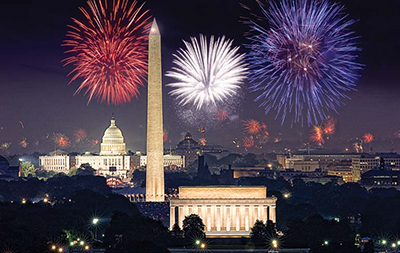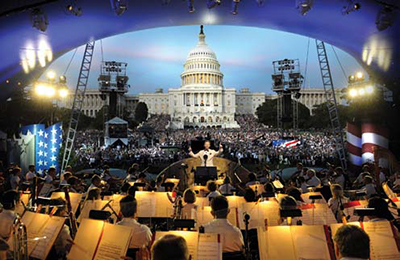PBS Live: Remembrance and Celebration

WASHINGTON—This summer, PBS continues its longstanding tradition of airing two premier celebrations of America’s most important holidays—the “National Memorial Day Concert” and “A Capitol Fourth.” Both are co-produced by Capital Concerts and WETA, in Washington, D.C.
These 90-minute shows draw hundreds of thousands of spectators to the West Lawn of the U.S. Capitol as well as millions of PBS viewers. They feature big name singers, bands, celebrities, a full orchestra, as well as U.S. military choruses, marching bands and color guards. While both shows share technical and production standards, they strike a different tone.
This year marked the 25th anniversary of the broadcasts of the “National Memorial Day Concert” and the 34th anniversary of “A Capitol Fourth.”
PBS’ “National Memorial Day Concert,” which aired on Sunday, May 25, is a somber tribute to the men and women in uniform and those who gave their lives. The show’s many video profiles, performances and tributes recognize the service and sacrifice of our nation’s war heroes, veterans and their families. PBS’s “A Capitol Fourth” is a celebratory birthday party for the country, with upbeat singing, dancing and spectacular fireworks.
“These shows are a gift to the country. They’re not selling a product nor are they commercialized in any way,” said Jerry Colbert, executive producer and founder of Capital Concerts, Inc. “Live television has the uncanny ability to unify everyone. This is a national experience that all Americans can share and there are no politics involved at all.”
Every year, Colbert has worked hard to get corporate sponsorships from companies such as Lockheed Martin, General Dynamics and Boeing, with travel considerations provided by American Airlines. Describing the shows as a public/private partnership, Capital Concerts also receives support from the Corporation for Public Broadcasting, U.S. Department of the Army, and National Park Service, among others, with security provided by the United States Capitol Police.
These contributions cover the high production costs associated with these complex live outdoor concerts. For example, as bad weather can jeopardize the live shows, Capital Concerts designed and built a 12,000 square-foot bandshell made of translucent white fabric strong enough to withstand more than 90 mph winds. As a fail-safe measure, the production company also records the full dress rehearsal the night before and cuts to it if bad weather should prevents the live show from continuing.
Get the TV Tech Newsletter
The professional video industry's #1 source for news, trends and product and tech information. Sign up below.
LIGHTING AND AUDIO
For the huge crowds, there are big-screen video displays on either side of the stage and one massive video display above it, which is hoisted into place by a 200-ton crane. The stage floor consists of plywood panels, with the top and bottom sides painted for the respective events. As the venue goes from sunshine to sundown, Lighting Director Bob Barnhart manages the lighting mounted on one or two Musco HMI lighting towers near the tent, and an aluminum theatrical grid inside the tent above the stage.

As inclement weather conditions can jeopardize the live shows, Capital Concerts designed and built a 12,000-square-foot bandshell that can withstand winds of more than 90 mph. “One of the most challenging aspects of the production is the audio,” said Hugh Healy, audio engineer from NEP Denali, which supplies California, its large 62-foot video mobile unit (tractor/trailer) equipped with exceptional audio mixing capabilities. The truck has a 90-input GV Kayenne KFrame video production center (and Abekas DVEous DVE), Calrec Apollo audio console with 144 multi-layered faders and Avid Deko for real-time broadcast graphics.
For the Memorial Day event, the California truck can handle it all. However, as the July 4th concert involves more musical performers—with hundreds of I/Os, lots of submixing, mix-minuses, and even ProTools recording for post broadcast remix— Capital Concerts arranges for a separate music truck from MTV, and Firehouse provides sound reinforcement systems. This additional truck and gear help the production handle audio mixing of back-to-back musical performances.
“Especially for ‘A Capitol Fourth,’ we typically end up with about 150–175 simultaneous inputs just for the microphones alone, including a separate mic for each member of the orchestra,” Healy said. “That doesn’t even count all the inputs for guest bands and performers that the stage and audio crews set-up on our various stages. Needless to say, we’d be lost without a stage crew capable of fast, accurate setups. This includes making sure to switch over all the audio inputs that need to be routed simultaneously to the broadcast trucks, performers’ monitors and the front of house mixer.”
CAMERA COVERAGE
The West Lawn and National Mall areas are covered by 20 Sony HDC-2500 multiformat cameras, including: the main stage, one or two satellite stages, cameras at The Lincoln Memorial and The Washington Monument, plus another stage with a jib camera on the balcony of the Capitol. Two Steadicam operators get crowd shots and circle the stage for close-ups of performers.
Among the singers to be featured in this year’s “A Capitol Fourth” are: Jackie Evancho, Megan Hilty, Patti LaBelle, Michael McDonald, Sara Evans and Frankie Valli. The program is hosted by Tom Bergeron and also feature the National Symphony Orchestra under the direction of conductors Jack Everly and John Williams.
“Since these stages can be 70–150 feet apart, that distance causes audio delays and latency that makes it extremely difficult to keep all the live audio and performers synchronized,” said Healy. “If a singer on the satellite stage is performing with the orchestra on the main stage, the singer and conductor need to rely on wireless in-ear monitors for the program sound and cues they need to follow—and the orchestra has to follow the conductor’s timing—and ignore the acoustic sound they’re hearing from the other stage.”
Healy added that with no commercial breaks, crews have to use headphones to monitor the sound on the stage they’re setting up while another act is performing on the other. “The bands are set-up on moving carts with the microphones pre-set so crews just wheel them out, and plug in a single multicore cable into the splitter on the stage,” he said. “Audio for broadcast travels via a Calrec fiber transport system to our truck and mixer inputs.”
With so much wireless gear in use— including instruments and devices by the bands, intercoms for truck personnel and stage crews, and wireless HD cameras—a frequency coordinator constantly scans and manages RF access. If anyone fires up a wireless device without advance permission, they are swiftly dealt with, as the show’s success depends heavily on wireless RF communications and transmission.
Jerry Colbert and his son, Producer Michael Colbert, spend much of the year preparing for each summer’s concerts. In addition to lining up the talent, they pull together an award-winning production team of people at the top of their game in the TV industry such as producer Walter C. Miller (“The Grammys” and “The Annual Country Music Awards”) and director Paul Miller (“Saturday Night Live” and “The Annual Country Music Awards”) and chief engineer Tad Scripter (“The Oscars”).
“Since many key crew people have worked on these Capital Concert events for over a decade, they can handle any problem or issue that arises as well as elevate the creativity and production values that PBS viewers have come to expect,” Colbert said.

